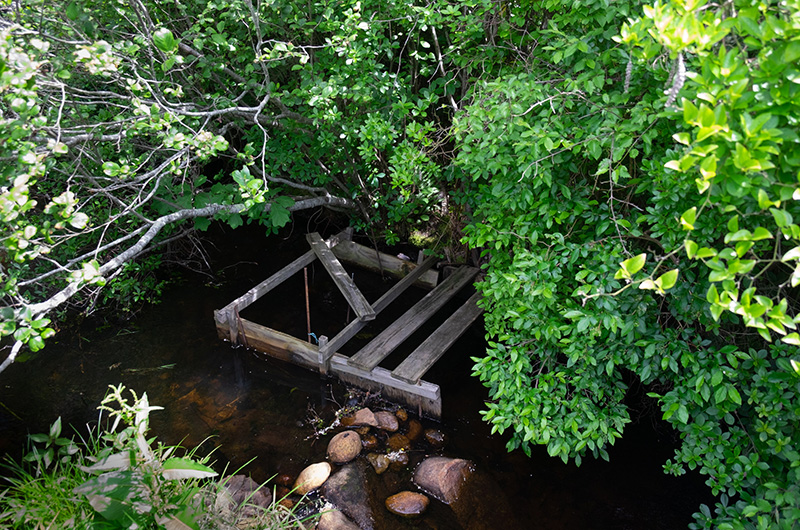High water temperatures, water diversion and inflated levels of nitrogen and phosphorus all threaten the vast Mill Brook river system and some of its most vulnerable species, a years-long study concludes.
First proposed in 2010, the Mill Brook watershed study will become the basis for a management plan for the West Tisbury portion of the watershed, which covers 2,460 acres. Scientists with the environmental consulting firm ESS Group and Vineyard wildlife research organization BiodiversityWorks collected data along with a large group of volunteers. The study cost about $41,000 and was paid for with town funds and a grant from the Martha’s Vineyard Commission.
A public forum to discuss the findings will be held on Monday at 5 p.m. in the West Tisbury Library.
Stretching from the morainal hills of Chilmark and West Tisbury off North Road down to the Tisbury Great Pond, the watershed is one of the greatest contributors to the pond. Water flow varies from year to year, but on average, 1.4 billion gallons of water pass through the watershed annually, the report found.
Among other things, researchers took into account speed, depth and temperature of the water at several sites along the brook, its ponds and tributaries. They also tracked the chemical makeup of the water, and a biologist indexed species living in the stream and ponds. Most data for the report was collected between 2015 and 2017. Though the study was extensive, its authors repeatedly caution that it should only serve as a baseline, and data collection should continue.
The stream system, which includes the two tributaries Witch Brook and Indian Hill Brook, is designated as a cold water fish resource (CFR) by the Massachusetts Division of Fish and Wildlife. Fish species that have historically lived in the stream, like the Eastern Brook trout and the American Brook lamprey, need cooler water to survive.
The study found that while water temperatures stay cold in the northern reaches of the watershed, temperatures can reach nearly 90 degrees Fahrenheit in areas below two of the lower ponds, where the sun heats the still water. Warmer water can hold less oxygen than cooler water, and those temperatures can prove lethal for cold water species.
In addition to solar impact on ponds, low water flow and lack of canopy can both contribute to temperature rise, the report said. One notable finding cites a pooled area of the watershed that lies off Scotchman’s Bridge Lane; historically the small pond has been used not only for firefighting but also by landscapers and pool companies. “As a result of these withdrawals and diversions along the Mill Brook, there is often insufficient water flow in late summer,” the study said.
The study found high levels of phosphorus throughout the watershed, and high nitrogen levels in some areas. Phosphorus and nitrogen come from fertilizers and animal waste and can contribute to algae growth, which depletes oxygen levels in the water. During the study, one farm located in the watershed changed its practices to limit livestock access to the brook. Doing so improved the quality of the water in the area noticeably.
Though some nutrient levels were high, no pesticide residue was found in the brook during the study.
The study tracks land use changes in the watershed and cautions that additional development could contribute to contamination.
“Aquatic health is the direct result of activities and land use development throughout the larger watershed,” it reads.
In 1985, there were 255 houses in the watershed area. In 2005, there were 360 houses. Under current zoning, another 507 houses could be built in the watershed, the report found.
The study recommends that the town develop a strategic acquisition plan for properties along the brook deemed critical to its health.
It recommends continued collection of data to expand the understanding of watershed health. It also suggests replacing culverts that impede flow and working with interested landowners to remove some of the dams along the brook. The 47-page report does not explicitly recommend removal of the dam at the Mill Pond — a topic that has been hotly debated in recent years — but it does sketch a possible alternative involving the creation of a new brook that would flow uninterrupted around the pond. On another topic that has been widely debated, the study found that the pond has not filled in with sediment despite concerns about water levels possibly dropping.
Following Monday’s forum, the selectmen will take steps to begin a management plan.










Comments
Comment policy »